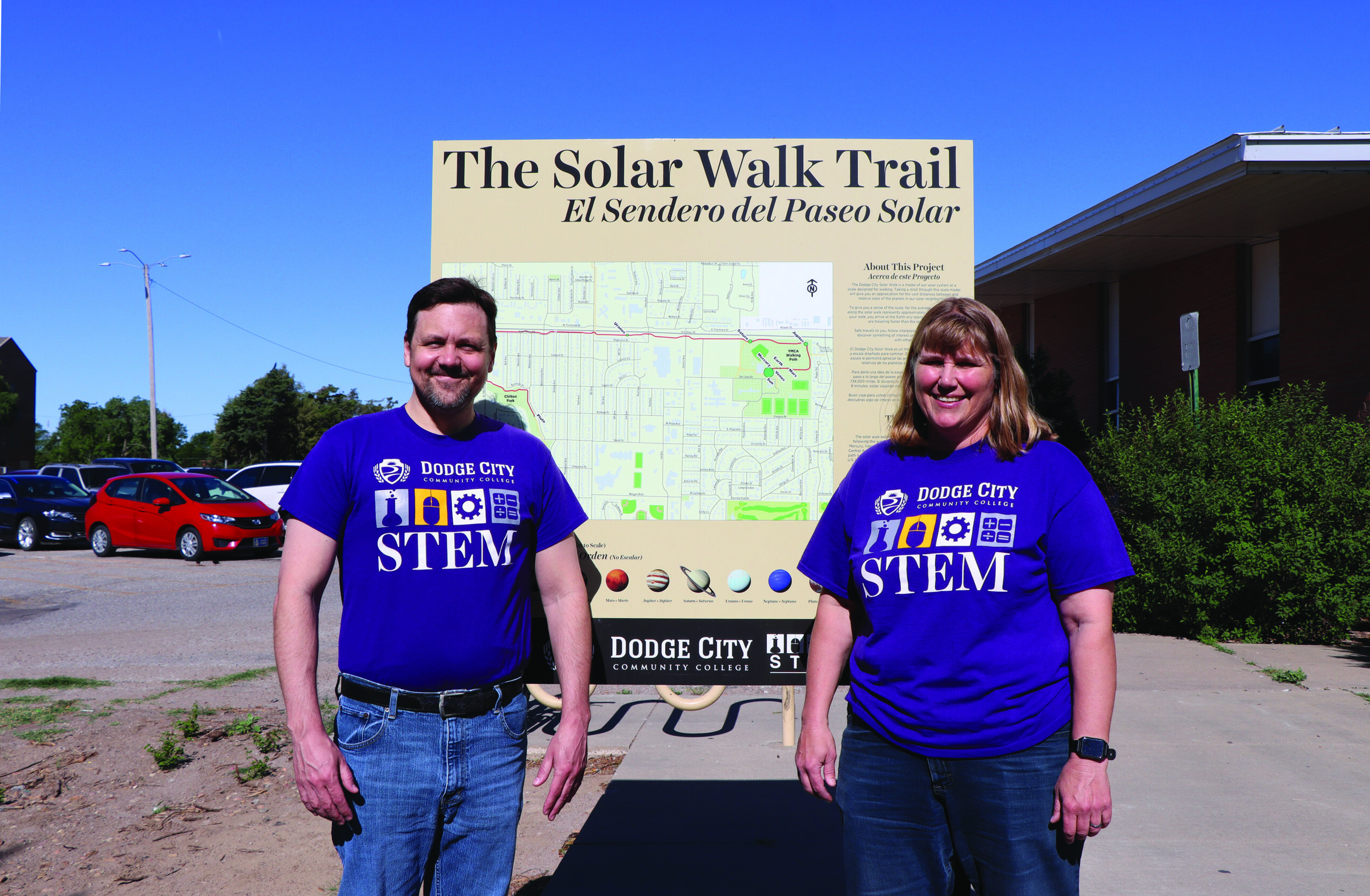DC3, City Partner for Solar Walk Project
Published May 29, 2024

Through a new partnership between DC3 and the City of Dodge City, a new Solar Walk has been added to the Gunsmoke Trail walking path. [Photo by Lance Ziesch]
Because of a new cooperative effort between Dodge City Community College (DC3) and the City of Dodge City, users of the Gunsmoke Trail walking path can now experience a scale model of the solar system while they exercise.
The idea for the new Solar Walk Trail, which begins in the St. Mary’s Complex by the Dodge City Family YMCA, grew out of an astronomy and physical science lab taught by Sherry Curtis Rogers, DC3 Professor of Physical Science.
“In the labs, we would compare the relative size and distances of the planets and Mr. Sun,” Rogers said. “We would scale the distances in the hallway. During the COVID-19 spring, when I couldn’t see my students every day, I built a scale model of the solar system on a two-mile stretch of county road, just east of our house, to teach the content.”
After the “COVID dust settled,” Rogers said she realized it would be useful to have a scale model of the solar system somewhere on the DC3 campus.
“I wandered around campus a few times looking for a long enough path to build it, but I just couldn’t find a good spot,” she said. “That is when I reached out to Melissa McCoy at the city about building it along the walking path.”
McCoy, who serves as the city’s assistant city manager and public affairs person, showed other city employees the video Rogers had made for her class of her “county road” solar system, and they were all intrigued, Rogers said.
“They liked the idea, but they wanted Pluto to be included!” she said. “So, my faithful colleagues—Dylan Faullin and Stephanie Gruver—and I started making plans.”
Rogers said she then had one of her astronomy classes make a scale-size display for a class project to visualize the relative size of the planets.
“Then, we started pacing off the distance to the planets,” she said. “I wanted the walk to start at the YMCA, and I wanted Neptune to be at the corner of 14th Avenue and the bypass by the college.”
After Rogers and her colleagues figured out the scale for the Solar Walk, they turned the idea over to Lance Ziesch, in the DC3 Marketing Department, to design the signs. In addition to having images and information about the sun and each planet, the signs also needed to be in both English and Spanish and feature a QR code to the project’s website at dc3.edu/solarwalk2.

Dylan Faullin, DC3 Professor of Math, and Sherry Curtis Rogers, DC3 Professor of Physical Science, at the starting point of the new Solar Walk Trail, on May 22. [Photo by Lance Ziesch]
Dylan Faullin, DC3 Professor of Math, who helped determine the various distances listed on each sign, said he hopes the project will help people appreciate the vast distances between—and the relative sizes of—the planets in our solar system.
“To give people a sense of the scale of the Solar Walk Trail, for the average adult, each step represents approximately 734,000 miles,” Faullin said. “So, on your walk, if you arrive at the Earth any sooner than 8 minutes, you are traveling faster than the speed of light.”
The Solar Walk Trail begins with the Sun sign, Rogers said. It is located at the southeast corner of the YMCA building, and its reverse side features a large map of the entire project.
“Heading east and following the walking path, you will find the first six planets—Mercury, Venus, Earth, Mars, Jupiter, and Saturn—before reaching Central Avenue, which is within 0.6 miles,” Rogers said.
“Farther west along the walking path is Uranus, which is 1.14 miles from the Sun. At the corner of U.S. Hwy. 50 and 14th Avenue, which is 1.8 miles from the Sun, you will find Neptune. Finally, heading south on 14th Avenue and into Chilton Park, we find the dwarf planet Pluto, which is 2.36 miles from the Sun.”
The signs, which were manufactured by Luminous Neon and cost around $6,000, were paid for with funds made available from a Kansas Louis Stokes Alliance for Minority Participation (KS-LSAMP) grant through Kansas State University, Rogers said.
“KS-LSAMP is a program that promotes minority participation in STEM [science, technology, engineering and math] fields,” she said. That is how we paid for the signs. The city installed them, and my students and coworkers at the college did the rest.”
Although the finished signs were installed in March, Rogers said the project is far from over.
“This will be an ongoing thing,” she said. “This spring, I had my astronomy students create projects related to the Solar Walk. One student made an amazing podcast that walkers can listen to during their journey through the solar system. Some of the others developed a curriculum for elementary students.”
In addition to eventually adding her astronomy students’ content to the Solar Walk website, Rogers is also planning Facebook and Instagram pages for the project. And she said she is considering some other options, too.
“Later this summer, the city wants to have a ribbon cutting,” she said. “I’m thinking it might also be nice to have a fun run through the solar system for the kids. And for the adults, we could have a solar system 3.85 K run. The possibilities are endless!”
Thus far, Rogers said she and her colleagues have already received “a fair amount of positive feedback” from community members regarding the project.
“One lady’s son took her on a walk to Pluto for Mother’s Day,” she said. But no matter why people are out on the walking path, I hope the project makes them stop and think about the vastness of space and how small we really are.”
By Lance Ziesch
DC3 Assistant Director of Marketing and Community Relations